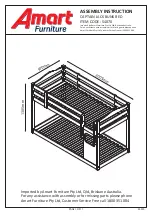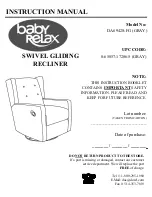
CARE INSTRUCTIONS
Conditions climatiques (vent, pluie, neige, grêle, vents salins)
Le mobilier d'extérieur est conçu pour être utilisé dans des conditions climatiques extérieures normales. De forts aléas climatiques ou
des conditions météorologiques exceptionnelles peuvent avoir des répercussions sur l'aspect, le bon usage et la durée de vie du
produit. Il est fortement conseillé d'utiliser une bâche disposant d'un système d'aération pendant la saison lorsque le mobilier reste
dehors.
Pluie et humidité
S'il est laissé sous l'eau, le mobilier mettra plusieurs jours à sécher. Rien d'anormal à cela, mais veiller à l'essuyer et éviter que l'eau
ne stagne dessus. La présence humidité prolongée accélère le vieillissement produit et favorise l'apparition de rouille voire de
moisissures.
Conditions de températures
Le mobilier extérieur n'est pas fait pour supporter des conditions de températures basses, encore moins des températures hivernales,
qui sont susceptibles d'altérer son bon fonctionnement et son état de surface. Il est également sensible à l'humidité ambiante. Il est
donc conseillé de le remiser dans un local sec, aéré et clos. Le bâcher n'est alors pas nécessaire. Avant tout remisage, nettoyer et
bien sécher les produits, afin de prévenir l'apparition d'odeurs désagréables ou de moisissures.
Si vous ne disposez pas d'un local sec, aéré et clos, l'utilisation d'une bâche disposant d'un système d'aération est indispensable pour
recouvrir le mobilier qui reste dehors. Une bâche de protection permet en effet de réduire l'impact des agressions extérieures
(dégradations dues aux arbres, animaux, pollution, etc.) sur sa durée de vie. Si le sol est humide, il est conseillé d'insérer une cale
entre le sol et les pieds pour éviter un transfert d'humidité. Dans le cas d'une table qui hiverne dehors, donner un léger angle permet
également d'éviter l'accumulation d'eau et de feuilles mortes sur la bâche.
En cas de non usage prolongé, si les préconisations de stockage et rangement ne sont pas suivies, il en résultera une détérioration
accélérée de son état de surface et de son bon fonctionnement.
Protection de la visserie et de la structure
L'acier est un matériau qui exposé aux éléments extérieurs (humidité, vents salins) va naturellement s'oxyder. Ce phénomène naturel
n'endommage pas ni ne réduit la résistance du mobilier. Afin de prévenir l'apparition de rouille, notre mobilier en acier est livré
d'origine avec un traitement Epoxy. Toutefois cette couche disparait progressivement sous l'action des éléments extérieurs et doit être
renouvelée régulièrement. Pour cela, appliquer un aérosol antirouille au moins une fois en début et en fin de saison (disponibles en
quincailleries ou magasins de bricolage). Augmenter la fréquence de traitement tous les 3 mois pour du mobilier exposé aux vents
salins en bord de mer.
La visserie doit également faire l'objet d'un tel traitement.
Si de la rouille apparait malgré tout, elle peut être facilement éliminée avec des produits usuels tels que du vinaigre blanc ou de l'acide
citrique. Un chiffon imbibé de polish automobile peut également vous permettre de faire disparaitre les points de rouille. Terminer avec
un spray antirouille pour protéger le mobilier, à appliquer régulièrement.
Déperlance
Il s’agit d’un traitement de surface appliqué sur une matière, pour lui conférer la capacité de laisser glisser l'eau à sa surface au lieu de
l’absorber. Comme tout traitement de surface, il va disparaitre avec le temps. Il disparaitra d'autant plus vite que la matière est
exposée aux éléments extérieurs (pluie, vents salins, salissure, frottement). Il est nécessaire de renouveler le traitement dès que la
matière perd sa déperlance ou après chaque lavage. La déperlance ne doit toutefois pas être confondue avec l'imperméabilité. Même
traité, un tissu ne peut prétendre à une parfaite étanchéité, en particulier au niveau des coutures. Sa résistance à la pluie est donc
limitée. Un tissu exposé à la pluie, même lorsqu'il est déperlant, va être mouillé et doit être mis à sécher.
1/ Your product
Properties
Part of the frame is made up of aluminium parts (for its lightness) and epoxy painted steel parts (for its sturdiness).
Aluminium is a light, resistant material that doesn't rust.
Epoxy steel is a steel covered with a protective paint against rust.
Polyester is a synthetic fabric that offers good resistance to tearing and rubbing.
Manufacturing and assembly
The manufacturing then assembly of this product requires leaving clearance between the different parts.
It is therefore normal to observe gaps/slack that may reach several millimetres between the different assembled elements (between
two slats, between boards...).
This tolerance necessary for the correct realisation of your product can be behind little geometric differences.
This does not lead to any loss of function of your product.
Irregular appearance
Each product is manufactured and assembled industrially from parts whose surface treatment is carried out individually, before
assembly. These metallic elements cannot be free from appearance irregularities coming both from the surface treatment process
and assembly operations. The final appearance of the product is therefore directly linked to these possible irregularities.
Regularity of seams
Although we pay special attention to the quality and regularity of seams, it is possible to notice that some threads are not cut after the
break point of the seam. There is no risk of the seam becoming undone. Cut this thread with a simple pair of scissors.
Size of the cloth
The size indicated always corresponds to the size flat of the cloth. The useful size is slightly less, due to the angle given to the cloth
by the parasol.
2/ Precautions for use
We cannot guarantee the good behavior of this product under difficult atmospheric conditions.
We recommend closing the umbrella during strong winds, thunderstorms, hailstorms or heavy rain. In these conditions, it is
recommended not to be under or near the parasol.
After each significant bad weather we invite you to check the general condition and the solidity of the structure before use. Attention,
danger of overturning in the event of a gust of wind.
Fold the parasol in case of wind and strap it.
It is recommended not to leave an open umbrella unattended.
The accumulation of water and / or dead leaves on the canvas contributes to its degradation and to that of the structure: make sure to
clean it regularly and to eliminate any pockets of water.
Do not hang products on the frame.
It is necessary to fix the parasol in a stable, weighted base and on a flat surface.
We do not recommend mounting a light fixture or other heat source on the structure in contact with or near the fabric.
Watch out for knives and other sharp objects being handled nearby. Also watch out for cigarette burns and other sources of heat.
3/ Maintenance and ageing, siding
It is normal to note natural wear and tear of the product over time and with use, in the form of an alteration of the colours and the
state of the surface, the mechanical functions and tightening of the screwed elements.
Tightening
The assembly parts of your product become loose over time. Think of tightening them regularly.
Exposure to UV rays
Over time, you can see a discoloration of the materials exposed to UV rays (textiles, paint, plastics), a phenomenon also due to the
rays of the sun as well as those of the moon. This evolution of colours exposed to external elements is normal and concerns in
particular bright colours.
Everyday maintenance
Your product is subject to external elements, it must therefore be regularly cleaned.
Remove stains immediately.
Clean with a damp cloth soaked in warm soapy water (or hot water for more marked dirt) or a specific, adapted product.
Rinse thoroughly.
Finish with a clean, dry cloth.
If in doubt, consult a reseller or the material sheet on the Hesperide.com website.
In the absence of regular cleaning your product will imperatively deteriorate.
Weather conditions (wind, rain, snow, hail, salty winds)
The outdoor furniture is designed to be used in normal outdoor weather conditions. Strong climatic hazards or exceptional weather
conditions can have repercussions on the look, correct use and lifespan of the product. It is strongly advised to use tarpaulin with a
ventilation system during the season when the furniture remains outside.
Содержание LOOMPA 165527A
Страница 14: ...A 1 B 1 REF PCE PIECE QTY DIM 48 1000mm...
































